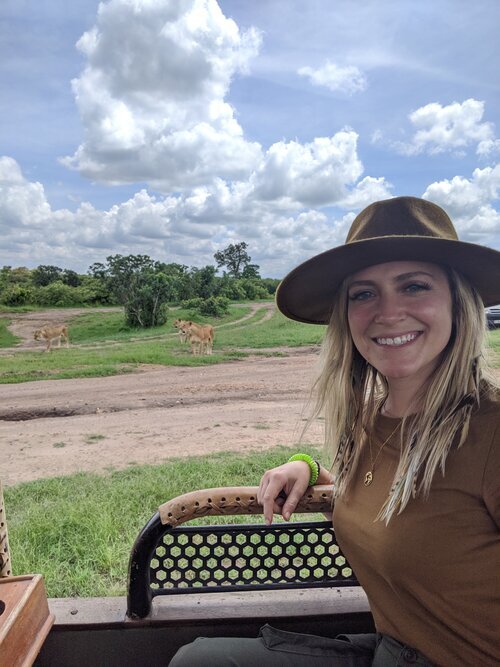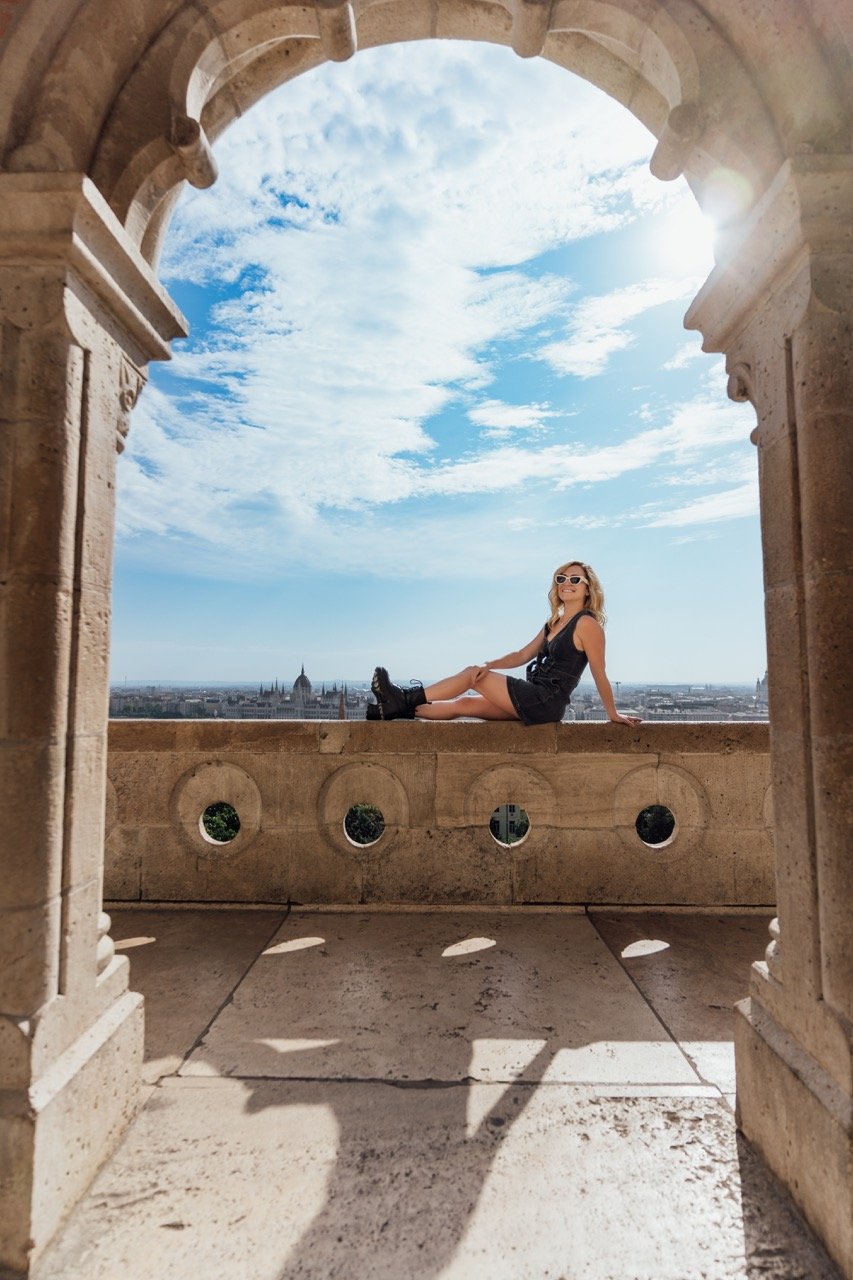How to Pack for Your First Safari!
Last year I visited South Africa and Zambia (with day trips to Zimbabwe & Botswana) and it was one of the coolest, craziest adventures of my life. I think part of the reason it was so special was that it was unlike any trip I had taken before. Safaris were a whole new world for me! And one that I am thoroughly obsessed with now.
Immediately after our 2018 Africa trip, we began planning our 2019 Africa trip (very typical me lol). And after a year of waiting, we are finally on our 2nd Africa trip!! This time to East Africa.
When I was in South Africa last year, I remember making so many mental notes to myself about packing and what I would do differently next time. With it being my first time, I didn’t really know what I was doing. I ended up wearing the same outfit like everyday because nothing else I brought was very suitable.
So I thought I would pull together a little safari packing guide to share with you on packing tips when embarking on a wildlife tour in this amazing part of the world. Happy reading!
As always, make sure you are traveling safely with TRAVEL MEDICAL INSURANCE
Packing Trip #1: Embrace the neutral palette for your day-to-day clothing.
When you’re on safari, you don’t want to stand out or draw attention to yourself with dark or bright colored clothes, so you’re generally recommended to wear “natural colors” (think beige, khaki, brown, tan, olive, etc.) And no, it’s not a gimmick! Bright/dark colors actually ATTRACT the tsetse flies (and you don’t want those coming after you, trust me!!!). And plus as an added bonus dressing the part for your big adventure is kind of fun (right?!)
Packing Tip #2: Pack lightly and use soft sided luggage.
When you’re on safari, you’re often on the go, spending only a night or two in each lodge. So having luggage that is easy to carry is important. You’ll also be sitting next to the luggage in the safari vehicle as you drive long distances between parks, so having something that you can lean against and get cozy with is really nice. (Whereas bulky luggage jamming into you = no fun!)
Packing Tip #3: Don’t be fooled by it being Africa, it can be chilly so bring layers!
Mornings and evenings can get very chilly on safari, so it’s recommended to bring layers that can easily be removed/added as needed. Depending on the type of safari, you may be out all day in the safari vehicle (or in several hours increments), and so you’ll want to be comfortable. Mornings I was often in scarf, jacket and hat. Whereas, during the day, I could be sweating profusely as we drove with the hot sun beating down on us. And the last thing you want is to be uncomfortable all day, so plan accordingly!
Packing Tip #3: Be ready for any type of weather—rain or shine!
Me in Nairobi National Park in my Kosan Raincoat
Safaris don’t stop due to a little rain, so you want to be prepared with a good quality rain jacket just in case you run into any inclement weather. I am obsessed with my rain jacket from Kosan. I’ve have never actually owned a nice raincoat until now (crazy huh!?) – and it seriously makes all the difference. A big thank you so much to Kosan for supplying me with this wonderful item for my safari.
I was so used to getting hot and sticky inside a cheap poncho. I had no idea how tolerable rain could be when you’re just dressed comfortably (LOL!). Kosan’s raincoat is made of super light, durable, waterproof fabric and folds up really tiny in my traveler’s backpack. It also comes with a traveling pouch—that you can actually successfully get back into (have you ever noticed how difficult it is to get some items back in their pouch once out?)
As an added bonus, the jacket is really cute (you can really tell the quality here!!) You are definitely going to be seeing this on me a lot! I tend to travel in rainy season often (fewer crowds, cheaper, etc.) so having a good rain jacket has been a game changer for me. Check out their kickstarter HERE!!
Packing Tip #4: The sun is really strong so plan accordingly!
It was actually surprisingly uncomfortable for me to leave the house without sunglasses. I had never really experienced that before. So you know the sun rays are STRONG there. Make sure you’re armed with extra sunglasses and plenty of sunscreen before you go.
For those of us who have a hard time hanging onto sunglasses, I also recommend getting a sunglass string. There are plenty of cute ones out there these days so you don’t have to look like an old lady.
When you’re driving under the Africa sun all day, you tend to get pretty sweaty. So I always recommend quick drying materials that you can wash in the sink in the evening, that can dry over night.
Packing Tip #5: Take all measure to prevent mosquito bites.
Do mosquitos love anyone else as much as they LOVE me? I swear I can be in a crowded room and being completely bitten up, while no one else has a single bug bite. NOT. FAIR. But one of the best ways to protect yourself from unwanted mosquito bites is to treat your clothing with permethrin ahead of time. Treat it with the clothes off your body and let it dry. It lasts for about 6 weeks (with weekly washes). It’s also toxic to pets, so make sure you spray in a pet-free zone. Once you’re clothes are treated, they are ready for you to pack!
I also recommend getting some of those mosquito bite bracelets - like THESE. In addition to these methods for preventing bites, it’s also a good idea to take pack malaria pills, in the event that you do get bitten. You can get these from a general practitioner doctor ahead of time (you generally have to begin taking them 7 days before you enter a malaria zone, so just something to keep in mind.)
Packing Tip #6: Bring a self-filtering water bottle on your trip.
On safari, you get hot and sweat a lot — you’re out all day in the sun. So it’s super important to make sure you are staying hydrated - I recommend drinking at least 2 Liters per day. And avoid too many diuretics like coffee, tea, etc.
A self-filtering water bottle - like this one HERE - is immensely useful especially when you’re traveling in countries where the tap water isn’t the safest to drink. If you want a cheaper option, you could go with THIS ONE, but it won’t protect you from viruses like SARS or Hep A (so if you’re going to be in an area where people/animals are near the water source, may be smart to splurge).
Packing Tip #7: A shawl/light scarf that can be transformed depending on the weather conditions!
Shawls have proven very useful on safari, as I can wear it as a scarf when I’m cold, drape it over my head when the sun is in my eyes, cover my shoulders to protect from sunburn, use it as a blanket, etc.
I have a Vinyasa Scarf from Lululemon that is my go-to travel scarf. It snaps open so you can use it as a blanket in addition to it’s scarf capabilities!
Packing Tip #8: Binoculars are your best friend
There is nothing more exciting than your tracker pointing to an animal in the distance! So make sure you have some binoculars with you so you can have a sharp view of the wildlife in all it’s glory. It’s also fun to scan the horizon and see if you can spot some animals first too!!
Some safari lodges will have these for you, but if you’re self-driving in a national park or your safari lodge doesn’t have them for everyone, you’ll want to make sure you have a pair.
Packing Tip #9: Weather resistant bag that has easy access to everything you will need.
Having done a lot of travel during rainy season and in places with inclement climates, water resistant bags have been a life-saver. A lot of waterproof bags require you to fold the top a bunch of times to close and have no pockets, but when you’re on safari you want to be able to easily access your stuff quickly (you never know when a cheetah will spontaneously arrive!). So just make sure whatever bag you choose, has some pockets or isn’t too gnarly to try to open.
Packing Tip #10: Books, Podcasts, Portable Games and things to do on long car rides
Many safari locations involve A LOT of driving. I’m not recommending you have your head down during the actual game drive, but between locations, it can be nice to have a good book, podcast, or portable games (whatever suits your fancy) with you.
Packing Tip #11: Cash Tips for Drivers, and Lodge workers
Remember to bring enough cash with you to tip your drivers/guides, trackers, chefs and lodge workers! In a lot of countries, they seem to prefer US dollars, so just look into what is preferred/customary before you leave.
Information on the internet can vary as to how much is appropriate but I think $20-25/day per couple for the guide, $10-15/day per couple for the tracker, and $10-15/day per couple for the Lodge Staff is usually a good area to be in.
Packing Tip #12: Protect your money with a money belt or valuables.
And since you may be carrying large quantities of cash on you, it’s a good idea to protect your cash by hiding it in a money belt. Something like THIS one from Amazon is small and useful OR if you only need a little cash on you, you could go something that looks more like an actual belt with a small hidden pocket for cash - check it out HERE.
Instead of a money belt, I’ve had a seamstress sew small pockets in my bras too. Another funny way I’ve protected my money!
Well those are my top packing tips when going on a safari. Have you been on a safari and are there any other items you think are must-brings?
xoxo
Lauren




![Top Things to Do in Kyoto [Updated 2024]](https://images.squarespace-cdn.com/content/v1/5e8ddd343f35e27090e69f6a/1735932144399-2AGWXO7DFPWT86TTGBCD/IMG_6753.JPG)



